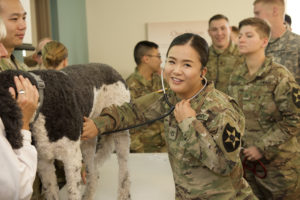By Addy Hatch, College of Nursing
A new partnership between the Washington Army National Guard 161st Infantry unit and the Washington State University College of Nursing brought 30 combat medics to the college for two days of training.
Working in the College of Nursing’s simulation lab during the second weekend of September, groups of medics rotated between practicing skills like starting IVs, giving injections, and inserting intraosseous catheters. Then they participated in a hands‑on patient care scenario in a Battalion Aid Station setting, treating a wounded soldier who was in an IED blast and firefight, treating gunshot wounds and shock brought about by severe blood or fluid loss.
“The realism here is invaluable,” said Capt. Matt Yamamoto, of the 1st Battalion, 161st Infantry Regiment.
Training in combat emergency medicine is typically done at Joint Base Lewis McChord’s Medical Simulation Training Center, near Tacoma. The Army National Guard was looking for equally high‑quality training in Eastern Washington to make it more convenient for the 1st Battalion, 161st infantry unit, which is headquartered in Spokane.

The Army National Guard contacted the WSU College of Nursing based on the college’s longstanding, successful partnership with the Washington Air National Guard, said Kevin Stevens, director of the Center for Clinical Performance & Simulation. Air National Guard medics have trained at the college’s simulation lab for a decade.
The training scenarios used the College of Nursing’s high-tech Human Patient simulation, Sim Man 3g, which can breathe, has pulses, bleeds, and can have a seizure. Groups of three medics worked on the patient, with a debrief at the end of the session.
The next day, the group returned for training on treating injured military working dogs. An Army veterinarian and technician from Fairchild Air Force Base came to the college with a working dog manikin to train the medics on how to take care of a sick or wounded working dog, which they may see in a deployed setting.
Stevens said she hopes to continue building on the College of Nursing’s new partnership with the Army National Guard.

“We want them to be able to stay on this side of the state and receive the same kind of training they’d get at Madigan Army Medical Center on the west side,” she said.
Capt. Yamamoto said he was pleased with the first training weekend, and with the College of Nursing’s sim lab.
“We’re just trying to leverage what we have here in Spokane,” he said.
Photos by Sarah Schaub and Addy Hatch.






